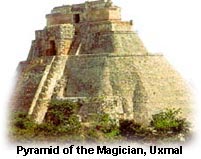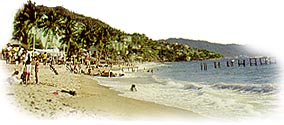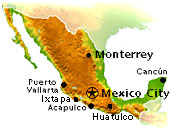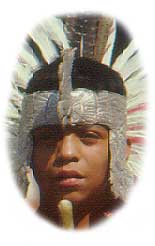
MEXICO
Explorations
 The
Yucatan
The
Yucatan
Dense with forests, ruins, and beaches,
the Yucatan Peninsula is apart from main- land Mexico in geography as well
as soul. It was the heartland of Mexico's Maya, as the ruins at Tulum,
Uxmal, and Chiche-Itza amply testify. Almost half of
Mexico's major archeological sites reside there. The Yucatan rests on a
massive limestone plate, and for eons its residents have drawn their water
from impossibly clear limestone wells called cenotes. The resort sprawl
of Cancun is by far the most visited spot, and many Yucatan lover's are
thankful - it leaves them more of the peninsula, including the diver's
paradise of Cozumel, the colonial cities of Campeche and Merida, and countless
small hideaways.
The Pacific Coast & Guadalajara
The Pacific Coast, long and well-developed,
is Mexico's national and international playground. The city names here grace
many a Manhattan travel agency come January: Puerto Vallarta, Ixtapa, Acapulco,
Huatulco, Manzanillo. The beaches, snorkeling, fishing, and weather are generally excellent.
excellent.
A few hours inland from Puerto Vallarta is Guadalajara, Mexico's second largest
city with a population surpassing 3 million. Despite its population, Guadalajara
retains a famous intimacy, and its weather is reputed to be the best in the hemisphere
with a year- round average of about 70F. The city has always been independent
in spirit, sometimes in government. It is the birthplace of mariachi music and
a traditional strong- hold of the church, which is evident by the many Cathedrals.
 Baja California
Baja California
The Baja peninsula is often the choice
destination for Mexico's adventure-minded visitors. At over 1,200 miles in
length, it is one of the world's longest and most remote peninsulas.
Most of the interior is a lunaresque badlands of desert, rocks, and forests
of cactus, while the 2,200-mile coastline hides thousands of beaches, some
well-known, some not. The Pacific Coast offers Mexico's best whale watching,
and The Gulf of California (also called the Sea of Cortes) is one of the
earth's riches seas due to mineral-laden waters that flow from the Colorado
River. The largest cities, Tijuana, Ensanada, and Mexicali are all found
in the far North, while the resort city of Cabo San Lucas lies at land's
end in the south. From the east coast city of La Paz, you can catch car ferries
across the Gulf to Matzatlan, Topolobambo, and Puerto Vallarta.
Mexico City & the Central Highlands
 As
if not wishing to leave any doubt as to where the nation's capital is, the
Distrito Federal has become the world's second largest city (just to be sure).
Mexicans affectionately refer to it simply as DF, "De Efe," and
one in ten Mexicans live there. It was built literally on top of the old
Aztec capital, Tenoctitlan. It is one the most important cultural centers
in the hemisphere, awash in cathedrals, museums, monuments, markets, art
galleries, parks, squares, and more. Don't, how- ever, be intimidated by
its size: many of the attractions reside in the Old City.
As
if not wishing to leave any doubt as to where the nation's capital is, the
Distrito Federal has become the world's second largest city (just to be sure).
Mexicans affectionately refer to it simply as DF, "De Efe," and
one in ten Mexicans live there. It was built literally on top of the old
Aztec capital, Tenoctitlan. It is one the most important cultural centers
in the hemisphere, awash in cathedrals, museums, monuments, markets, art
galleries, parks, squares, and more. Don't, how- ever, be intimidated by
its size: many of the attractions reside in the Old City.
Surrounding Mexico City are the Central Highlands, six states teeming with
colonial splendor: Guanajuato, Queretaro, Aguascalientes, Zacatecas, San
LuisPotosi, and
Michoacan. Many of the larger highland cities, such as Guanajuato, are beautifully
set into the mountains like elaborate colonial inlays.
The Great North
Mexico's North, a large area of deserts,
farmlands, and mountains, is the country's most sparsely populated region.
The vastness of the region has always given its people an independent, frontiersman
spirit. During the Revolution, the North produced almost all the rebel leaders:
Villa, Obregon, Madero, and Carranza were all norteņos. Along the 2,000-mile
US-Mexican border, the towns are an interesting mix of both cultures. Chief
among these is Monterrey, Mexico's third largest city and one its most important
manufacturing centers.
The South
The Southern States of Oaxaca, Tabasco,
and Chiapas are Indian country. In Oaxaca, the most Indians are either Zapotec
or Mixtec, and the Indian culture is visible in an astonishing array of color
and art unlike anywhere else in Mexico. Some of Mexico's most important archeological sites are
also here, including the mountaintop city of Monte Alban, and Mitla. Chiapas,
further south, hosts what many consider the most important Mayan ruin, the
city of Palenque.
archeological sites are
also here, including the mountaintop city of Monte Alban, and Mitla. Chiapas,
further south, hosts what many consider the most important Mayan ruin, the
city of Palenque.
The Gulf Coast
Mexico's Gulf Coast is dominated by
the state of Veracruz, where Hernan Cortes landed in 1519 and began his conquest
of New Spain. Today, the state is the base for the nation's large, nationally
owned petroleum industry. Though Veracruz is not really a beach-blessed tourism
center, the state has some prestigious claims to fame. In the northern part
of the state is El Tajin, the incredibly intact remains of a city built Huastec
and Totonac Indians that predates Christianity. In Veracruz, you can
also climb Mexico's highest peak, Orizaba (18,551 feet). Lastly, nowhere
in Mexico will you find better sea food.
Copyright (c) 1998-2008 interKnowledge Corp. All rights reserved.
